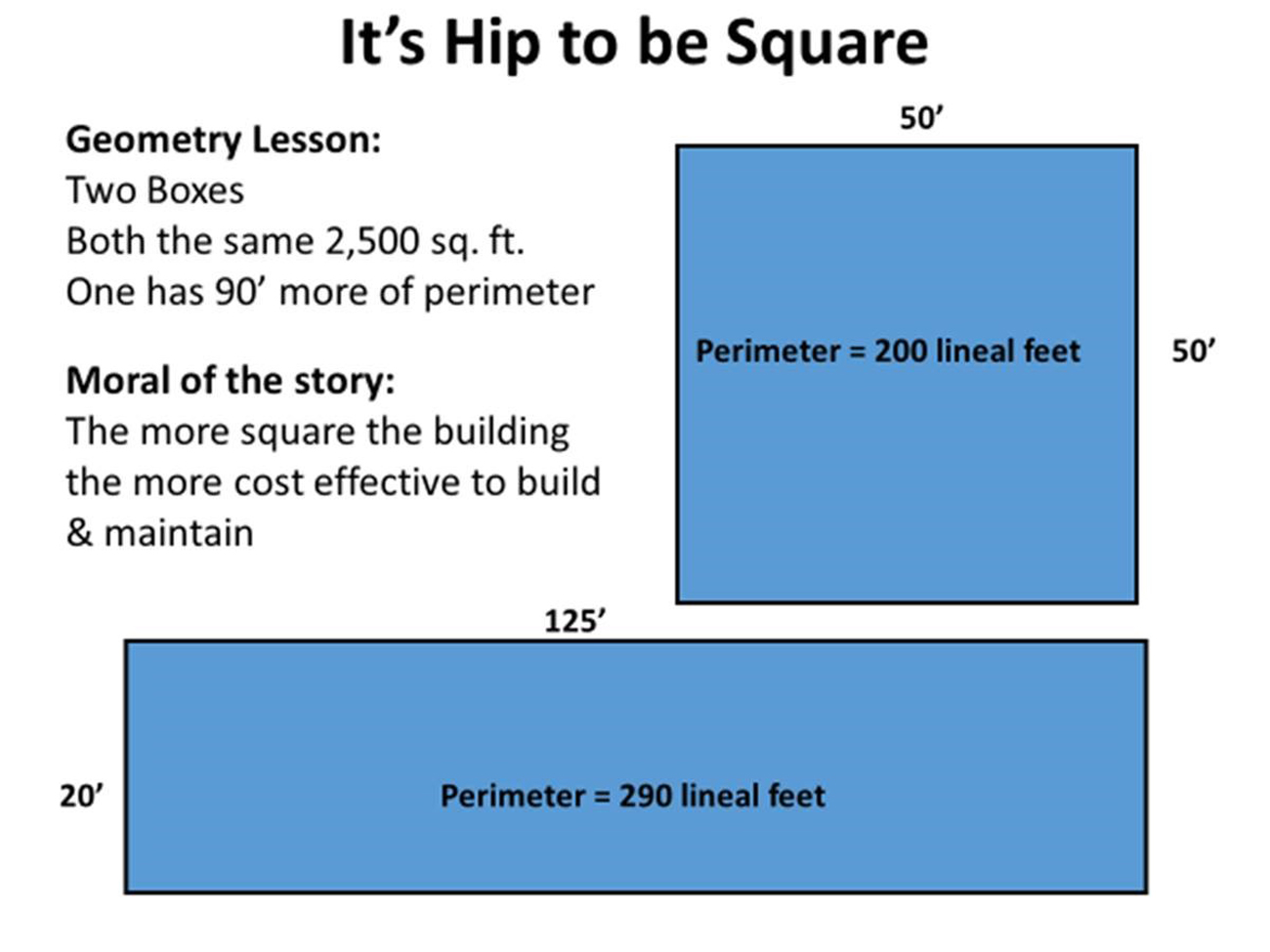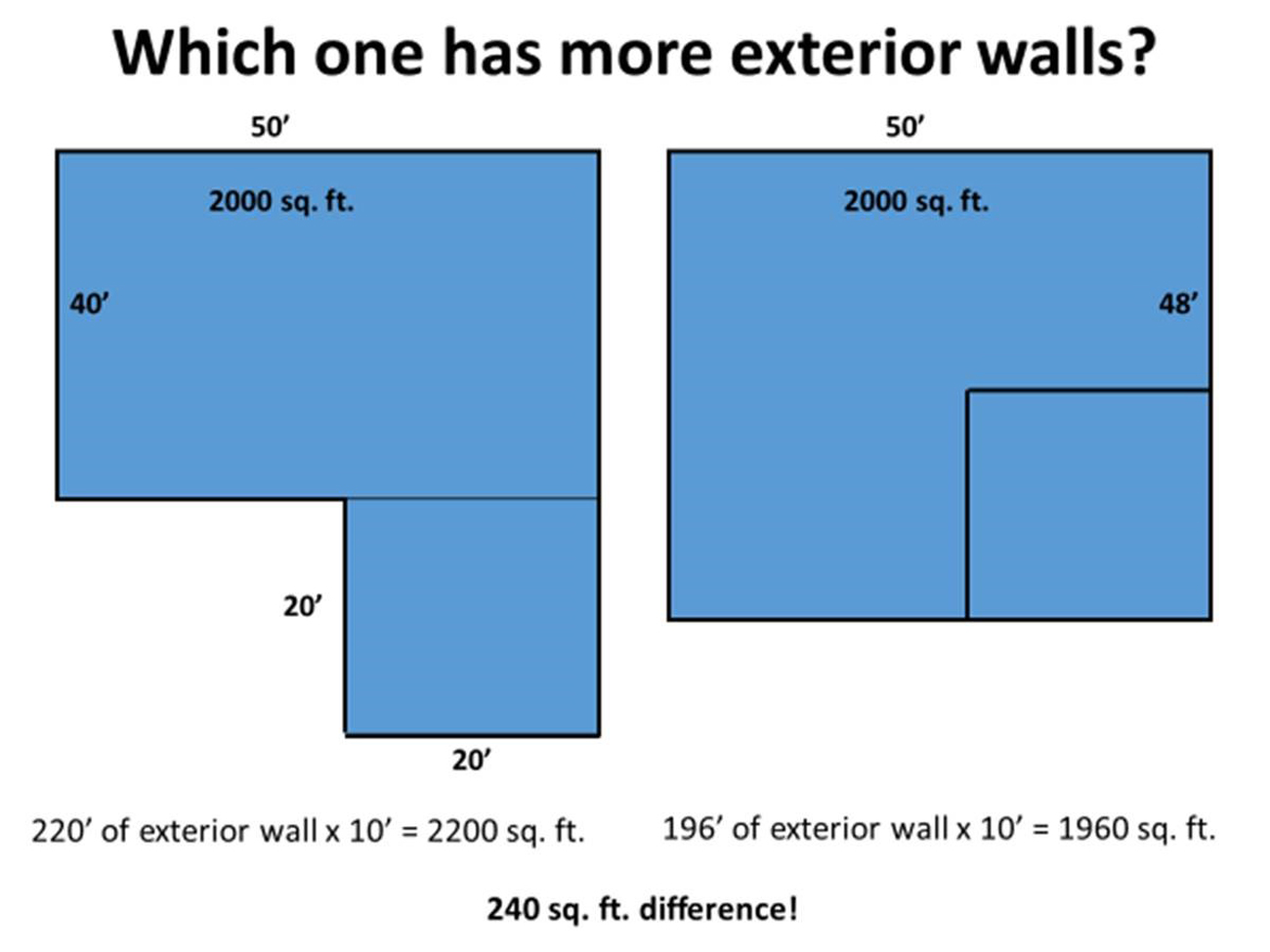Raise your hand if you loved high school geometry….
Half of my readers just clicked off and the other half ran screaming out of the room. Next question: Who loves saving on the cost of construction without sacrificing design? Indulge me for a few more lines, I think I can make this worth your time without too much brain strain.
It’s all about the Square Footage, Right?
This is a square footage based industry. “How much square feet is the house?” is one of the first 3 questions realtors and buyers will ask. Many will delve deeper, “What’s the cost per square foot? Builder X is selling their house for less per square foot than you. What’s up with that?”
Because of geometry, not all square footage is equal. Take two shapes: a 50’ by 50’ square and a 20’ by 125’ rectangle. Both have the same 2500 square feet of floor area. However, the square has less perimeter at 200 feet than the rectangle at 290 feet.
I can hear the folks in estimating right now – “So what? My framer charges me on square footage basis, what do I care if rectangle has 90 more linear feet of wall?” Stay with me here!
Think 3 Dimensional
Let’s take it one step further into three dimensions.
- That same 2500 sq ft shape has 10’ tall walls.
- Take that extra 90 feet of the rectangle: 90×10= 900 square feet of additional wall material compared to the square house.
- Let’s say you need to clad those walls in brick. Your brick supplier is going to do a takeoff on the amount of brick on the exterior so they can deliver enough material to get the job done.
Based upon brick at $6 dollars a square foot installed, the difference is $5400 of extra cost just based upon the shape. The takeaway: “Square it up” to create a more cost-effective structure.
Okay, but who would build a 125’ long house that’s only 20’ wide? It’s not out of the question to do a 20’ wide, two story home that’s 62.5’ long. When looking at three dimensions, the math is the same for exterior wall area.
Snout Garages Cost More Money
If you’re still with me, let’s keep examining the shape of our buildings. Say you want to build a cost-effective 50’ wide, 2,000 sq. ft. ranch plan with a two-car courtyard entry (snout) garage. Snout garages stick out in front of the house. In geometric terms, you have a 50’ by 40’ rectangle for the house and a 20’ by 20’ square for the garage. Two simple shapes must be cost effective, right? Well, no.
If you had opted for a front-loaded garage that was in line with the rest of the house (non-snout), you would have a 50’ wide by 48’ deep, almost square building pad. I’ll do the math for you:
- The snout (garage-forward) has 220 linear feet of exterior wall.
- The integral garage, almost square house, has 196’ of exterior wall.
- 24 additional linear feet of wall for the snout garage!
- 24×10′ tall walls= 240 additional square feet of wall for the snout – all for the same interior square footage of floor area. The dollars are adding up…
But wait! There’s more! The “snout” courtyard entry garage has more driveway – again, more cost. To save money, you may convert this to a front-entry garage, lessening the pain on the cost side but sacrificing 12’ of backyard in the process. With shrinking lots, 12’ could mean difference between having room for a pool or not. Have I made my case yet?
Value Engineering
Isn’t value engineering all about adding things buyers value while eliminating unwanted or hidden cost? In our integrated vs. snout garage, we were able to give the buyer something they value; 12 more feet of backyard, while eliminating 240 square feet of exterior wall. Sounds like a win, win to me.
In this industry, square footage is king. But it is not just square footage of the floor plan, but the total square footage of the three-dimensional home you’re building include the square footage of wall, driveway and backyard. Huey Lewis was right. In terms of the building industry, its hip to be square.
Categorized in: Value Engineering
This post was written by Housing Design Matters




